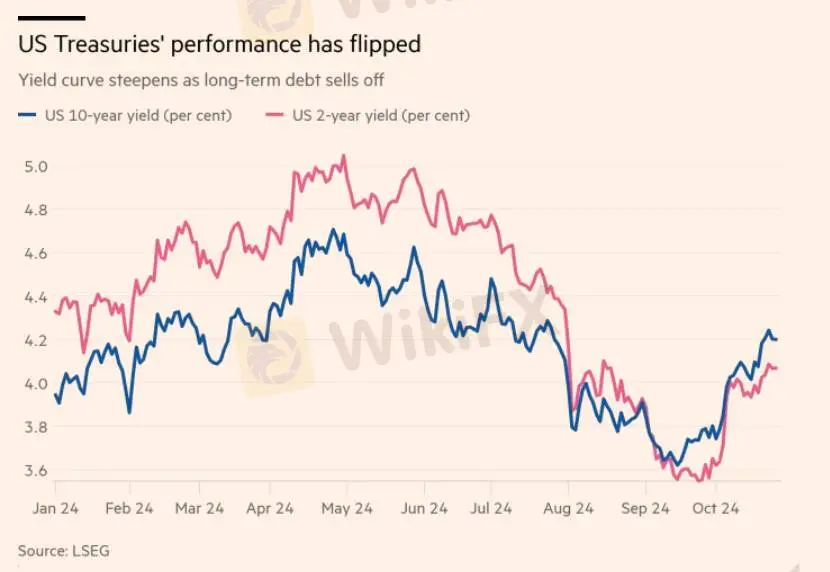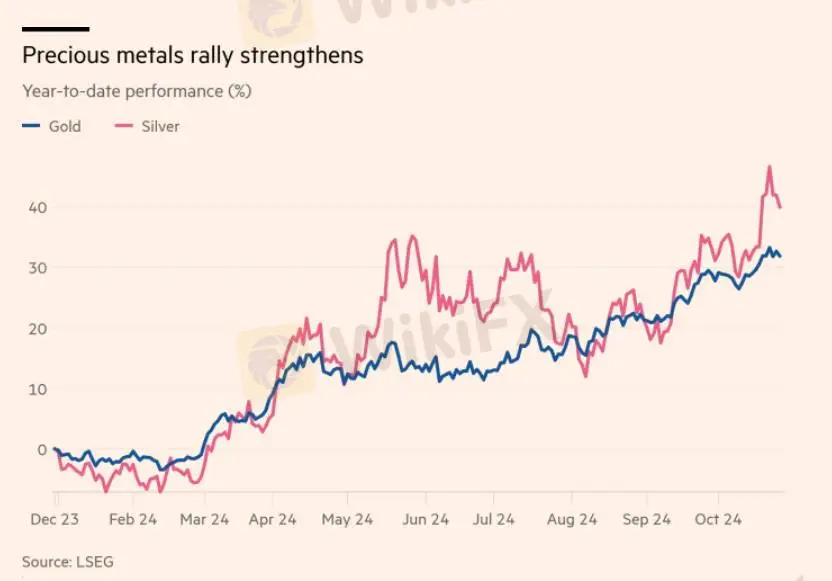简体中文
繁體中文
English
Pусский
日本語
ภาษาไทย
Tiếng Việt
Bahasa Indonesia
Español
हिन्दी
Filippiiniläinen
Français
Deutsch
Português
Türkçe
한국어
العربية
【MACRO Insight】 Precious metal prices soar: safe-haven assets amid fiscal and political uncert
Sommario:The Treasury market is experiencing sharp volatility as the US election approaches, mainly due to strong economic data and the markets reassessment of the Trump deal. The rise in the 10-year Treasury
The Treasury market is experiencing sharp volatility as the US election approaches, mainly due to strong economic data and the market's reassessment of the "Trump deal". The rise in the 10-year Treasury yield broke through 4.2%, which marks that US government bonds may be facing one of the worst performing months in recent years. Previously, the Federal Reserve's interest rate cuts had triggered market expectations for further easing, but the latest economic data and changes in the political outlook have caused investors to reassess these expectations.
Mike Cudzil, a portfolio manager at Pacific Investment Management Company (Pimco), pointed out that the market had some excessive enthusiasm after the Fed's rate cut, but now investors are "taking back" these sentiments. Rob Burrows, a government bond fund manager at M&G Investments, also mentioned that some investors made excessive dovish bets because they were afraid of missing the rate cut cycle, but now with the strong employment data, the market is beginning to panic.

The shift in the U.S. market has had a knock-on effect on global markets. The dollar has risen more than 3% against a basket of currencies over the past month, its best performance in two years. The yen has fallen below 150 per dollar and the Mexican peso has also been affected, linked to Trump's threat to impose tariffs on imported cars.
Mark Cabana, head of U.S. interest rate strategy at Bank of America, said recent economic data has reduced the likelihood of another 50 basis point rate cut by the Federal Reserve and dampened market expectations of a U.S. recession. Swap market pricing shows an increased probability that the Federal Reserve will keep interest rates unchanged in its remaining meetings this year, causing volatility in the U.S. Treasury market to its highest level since the end of last year.
Akshay Singal, global head of short-term interest rate trading at Citigroup, stressed that the increase in market volatility and uncertainty is partly due to investors paying more attention to employment data after inflation began to retreat. The weak data in July provided a basis for the Fed's decision to cut interest rates in September, but the subsequent employment report broke this expectation.

In global bond markets, investors are preparing for events such as the UK budget, the US election and key central bank decisions that could lead to short- to medium-term volatility being locked in. It is also expected that Trump's increased chances of winning the election could lead to policies such as tariffs and tax cuts that could fuel domestic inflation and put upward pressure on bond yields. Strategists also noted that the rise in term premiums represents investors' concerns about heavy government borrowing. Fiscal and political uncertainty boosted other safe-haven assets such as precious metals, pushing gold prices to record highs.
U.S. Treasury investors are now preparing for a prolonged period of uncertainty over the election and the economy, with strikes and hurricanes expected to make October's U.S. employment data difficult to interpret. Laura Cooper, head of macro credit at asset management firm Nuveen, said it's hard to tell where we are in the U.S. economic cycle because of the noisy data.
Still, some investors are now warning that global bond yields may have risen too high, with the U.S. and most other major central banks expected to remain in an easing cycle. Jim Caron, chief investment officer at Morgan Stanley Investment Management, stressed that inflation has been trending downward and the Fed is expected to still cut rates. He believes that bond yields are likely to remain contained, and this is unlikely to be the start of a new trend of rising yields, but just an adjustment.

Ed Al-Hussainy, senior global interest rate strategist at Columbia Threadneedle Investments, believes that the market's expectations for the Fed's rate cuts have shifted from overestimation to underestimation. The market is too optimistic about economic growth and too sensitive to the increase in fiscal deficits, which may lead to the market underestimating the actions that the Fed may take. He predicts that the market may reassess the Fed's rate cut path, which will affect the trend of bond yields.
Disclaimer:
Le opinioni di questo articolo rappresentano solo le opinioni personali dell’autore e non costituiscono consulenza in materia di investimenti per questa piattaforma. La piattaforma non garantisce l’accuratezza, la completezza e la tempestività delle informazioni relative all’articolo, né è responsabile delle perdite causate dall’uso o dall’affidamento delle informazioni relative all’articolo.
WikiFX Trader
WikiFX Trader
Rate Calc






